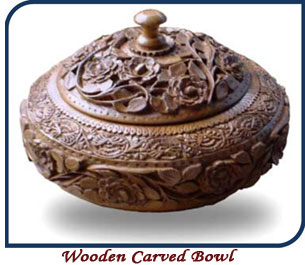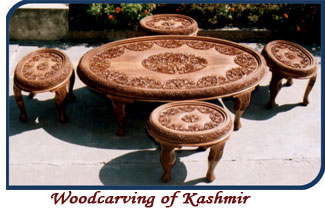Wood Carving...
 Kashmir is home to some of the best walnut wood carving done anywhere in the world. Wood carving is done on a variety of objects-ranging from furniture (tables, chairs, writing desks, dining tables etc.) to articles of personal use like cigarette boxes, cigar boxes, jewelry boxes, photo frames and various other articles.
Kashmir is home to some of the best walnut wood carving done anywhere in the world. Wood carving is done on a variety of objects-ranging from furniture (tables, chairs, writing desks, dining tables etc.) to articles of personal use like cigarette boxes, cigar boxes, jewelry boxes, photo frames and various other articles.
Walnut is the most common wood used for carving. Kashmir is the only part of India where the walnut tree grows. Its color, grain and sheen are unique, and the carving and fret work that is done on this wood is of the finest quality. Walnut wood from the root is almost black, and the grain here is much more pronounced than the wood of the trunk, which is lighter in color. The branches have the lightest color, almost blonde, and have no noticeable grain. The intrinsic worth of the wood from each part of the tree differs--wood from the root being the most expensive. There are several varieties of carving-deep carving, usually with dragon or lotus flower motifs; shallow carving, done all over the flat surface; open or lattice work, usually depicting the Chinar motif; and semi-carving, which is a thin panel along the rim of a surface, with perhaps a center motif. The advantage of semi-carving is that it allows the grain of the wood to be displayed, together with the carver's skill. Wax polishing brings out the inherent sheen of walnut wood, and is by far the most popular finish. Since varnish obscures the grain of the wood and alters its hue, it is rarely used. 
Relief wood carvings frequently adorn the cabinets, chairs, tables, jewellery boxes and ornamental caskets produced in Kashmir. Wood carving is also done on a large scale on the doors, walls and windows of traditional Kashmiri houses. Popular motifs of such relief carvings are the various kinds of flowers and plants in Kashmir. These relief carvings require a high level of expertise, patience and fortitude. Substantial amounts of walnut and chinar wood found abundant in the Kashmir valley allow a ready supply of raw materials for wood carving. Some of the walnut wood products-cigar boxes and trays, table-tops, handkerchief and collar boxes-are delicately carved. Floral designs of almost every conceivable variety are made with great accuracy of detail in chased or raise work. The best Kashmiri woodcarving is Khatam-band. Khatam-band refers to the carvings of relief patterns on the ceilings of rooms. The relief is made from thin panels of pine wood, and cut into geometrical designs. The craft is passed down from one generation of houseboats builders to another. This craft finds expression in the famous shrine of Khwaja Naqshband, near the Jama Masjid of Srinagar. 
Woodwork and wickerwork industries have flourished in Kashmiri. The artisans in Kashmir make boats which are of many sizes, and include the famous house-boats, the favorite residence of visitors during summer. The wickerwork involves chairs and tables, lunch and flower baskets, and various other articles of daily use. The earthen bowl of Kangri, the Kashmiri vessel used to counter the cold weather, is encased in wickerwork. |